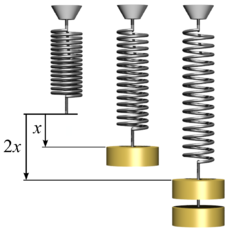Supplement 2.2: Planck's Radiation Law (2/2)
Energy of waves
According to the Law of Equipartition of Energy in thermodynamics, the mean kinetic temperature of an atom or another microparticle is determined solely by the absolute temperature and given by . is the Boltzmann constant (it is of no relevance right now, that this is a simplified exposition).
This expression meets the mean energy of a wave in a cavity as well. The mean value of the total energy of all waves in a frequency interval can be obtained by multiplying the mean energy of the single waves by , the total number of waves in that frequency interval:
Relating the total energy to the volume, we obtain the energy density of the waves within the frequency interval :
The equation of spectral energy density
is the Rayleigh-Jeans radiation law. It has been derived by Lord Rayleigh and Sir James Hopwood Jeans in 1900, within a narrow time frame to Planck's radiation law. It describes the radiation of black bodies at low frequencies, shorter than the radiation spectrum's maximum (or: at long wavelengths, longer than the maximum) quite reliably. However, the equation does not have a maximum. Instead, its values increase quadratically towards higher frequencies (or: lower wavelengths), which has been named the 'ultraviolet catastrophe' of this law.
Max Planck by contrast chose a different formulation than to approach the waves' energy. He considered the oscillating atoms at the surface of the cavity and set their kinetic energy equal to
with . The quantum number of the atomic oscillators corresponds to the mode number of the electromagnetic waves. In effect, Planck set the energy of an oscillator equal to the energy of the wave linked to it. This represents a quantization of the radiation, what caused the photon model to evolve.
The probability of an oscillator being in the state with the energy is named occupation probability of the state and it is described by the Boltzmann distribution:
The occupation probability decreases exponentially to an increase in energy. Temperature plays an important role in this case as well: high energy states are more likely occupied at higher temperatures.
The quantity in the denominator of the occupation probability is the so-called state sum:
The state sum is describable as a geometric series. The result is:
limits the occupation probabilities in a manner, so that its sum over all energy values equals 1 (or: 100%):
The thermic mean value of the quantum number of the cavity radiation is:
For easier legibility, we set , so that the sum expression becomes:
A conversion into the derivation with respect to simplifies the calculation notably, since the sum has already been calculated on the right-hand side at the beginning. It follows:
Application to the equation for provides the result for :
The mean thermal energy of the cavity radiation is then:
This expression replaces the mean kinetic energy mentioned at the beginning of this page. Considering this for the equation of spectral energy density, one obtains Planck's radiation equation:

